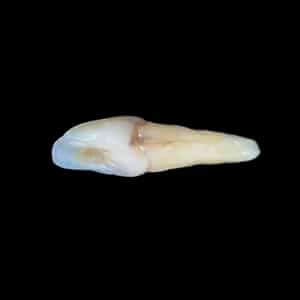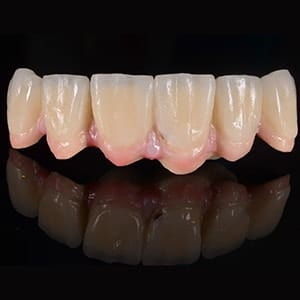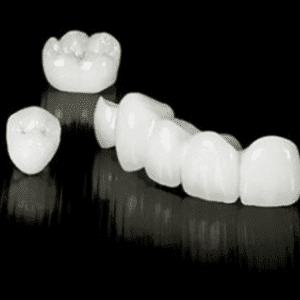FIXED
RESTORATIONS

Resin Crowns
Resin Crowns are constructed from composite material which is similar to the what is used for normal color fillings in the mouth. They are the most natural looking crowns. These are best suitable for restoring front teeth. They also do not wear down the tooth opposing them.
Presently in dentistry, acrylic polymer resins are most commonly used in crowns and dentures. Another common variety that is used is Polymethyl Methacrylate. This particular variety of resin is prepared by blending chemical units known as monomers along with activating chemicals. This enables the monomers to link together and react in order to form long chain polymers. With the reaction in progress, these resins may harden at room temperature.
Resin Crowns

Porcelain Fused to Metal
Porcelain fused to metal crowns (or PFM crowns) can be referred to as full-cast crowns which has porcelain fused on most or all parts of the tooth. Metal alloys with a high melting temperature are used to fuse porcelain to the surface and preventing the metal from melting. This ensures the porcelain to bond without changing its color.
When the tooth is prepared for such crowns, a large part of the tooth tissue is removed, making space for porcelain as well as the metal.
Porcelain crowns are the most preferred crowns as they easily match the color of the adjacent teeth better than the metallic crowns. However, they cause more damage to the opposite teeth than the resin and metal crowns. Some cases show that the porcelain portion of the crown can also break or chip off from the teeth.
In receding gums, such crowns are not suitable as the porcelain can start showing distinctively. They are best suited for the back and front teeth.
Advantages
- The underlying metal fused with the porcelain provides stability and strength to the crown.
- It has great aesthetic appeal and is most commonly preferred as it gives the restored tooth a natural look.
- They have a very high rate of success in the long run.
Disadvantages
- The cosmetic appearance of these crowns is commendable but they are less appealing than other types.
- They make the gums more vulnerable to gingival inflammation as compared to porcelain fused to gold and porcelain crowns.
- Restoring tooth with these crowns requires a large part of the tooth structure to be removed.
- Porcelain from the crown can easily break or chip off.
- The teeth which bite against these crowns bet worn out in the long run.
- Increased cost becomes a major drawback when precious metals are fused.
PFM crowns are nothing but a hybrid between porcelain and metal crowns. Initially a metal shell is prepared which can fit perfectly over the concerned tooth. Then a porcelain veneer is fused on the metal shell which gives the crown a natural looking appearance.
The best part of these crowns is the stability and strength which is unmatched to any other restorations available today.
These are best for patients looking for natural look and durability.
Recently there have been advancements in the field of porcelain fused to metal crowns. Patients with all porcelain crowns are getting theirs replaced with these ones. The latest type of Captek crowns have also done away with the black line that becomes visible around the patients gum line. These crowns have been the commonest option for dentists as well as for patients for over 35 years.
PFM is a preferred choice when bridges for the long run are required and night grinding is a problem. Since these crowns are a combination of porcelain and metal they are accepted worldwide and well known for the treatment they cater. They are trusted not only by the patients but also by the doctors all over the globe.
Porcelain Fused to Metal

Full Metal Crowns
Metal crowns generally make use of gold alloys or base metal alloys like that of chromium or nickel.
If compared to the other crown types with metal, minimal amount of tooth structure has to be removed and wearing out of adjacent teeth is also minimal.
Since these crowns are made of metals, they can withstand chewing and biting forces well and last for over a very long period. They hardly break or chip off.
The key drawback of metal crowns is their metallic color. They are best suited for restoring hidden molars.
Metal crowns are fixed in the same way as other crowns. It requires two successive visits to the dentist to get them permanently fixed.
On the first visit, a number of X-rays of the concerned tooth are done and then it is numbed. All decay is cleared and then an impression of the teeth is taken.
While the permanent crown is prepared, a temporary crown is placed on the tooth to protect it. After the permanent crown has arrived, it is cemented to the tooth permanently.
Full Metal Crowns

Diagnostic Wax Ups
An impression is taken of the mouth, which is given to a technician who then perfects the tooth shape and position with a white wax. Spaces get closed up, gum levels are raised (or lowered, or evened out), edges smoothed, and so on.

